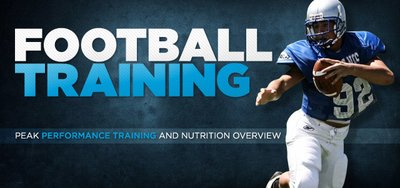From the return of pro football to St. Louis to the unexpected blow out win for the L.A. Wildcats over the DC Defenders, Week 3 was a memorable affair.
This episode includes our Week 3 awards, a look at the current XFL power rankings, and a good, crisp football talk with Jonathan Coachman of the XFL Pregame. Get a recap of all the action and dive into all the major stories throughout the XFL as we head on into Week 4! Follow us @XFLShow on all social media outlets! Call the XFL Fan Line anytime at 724-565-4XFL!
Football Preparation: Peak Performance Training and Nutrition Overview! from Bodybuilding.com
Baseball may be America's pastime, but football is its passion. Improve your game with the following training and nutrition actions.
It has been said that baseball is America's pastime, but football is its passion. Each year thousands of males (and some females) suit up to compete on the football field. Depending on the position(s) that one plays, there will be unique physical and performance characteristics that lead to better performance on the field.
The goal of this article is to provide an overview of those characteristics as well as highlight specific training and nutrition actions a football player can take to optimize both.
The Game
Football is played in a variety of climates ranging from severe cold to very warm and the players wear a full complement of pads and gear. Football games consist of four 15-minute periods or "quarters" with a halftime intermission of 15 minutes after the second quarter. This break between the 1st and 2nd half allows an opportunity for extended rest, refueling and rehydration.
College and professional football players are either part of the offense or defensive squad and thus are on the field for only half of the game. However, many high school players will play both offense and defense making rest, recovery, refueling and rehydration more challenging. Games are played once a week with a day of rest after and before the next and practice sessions in between.
In comparison to many other team sports, football has a shorter season and thus a longer off-season. In the United States, pre-season training tends to ramp up after the New Year with practices beginning in the spring.
For American football, summer camp generally begins in July with practices lasting two or more hours and may include the infamous "2-a-day" practice schedule. The regular season games begin at the end of August or beginning of September and continue through the fall and into the beginning of winter.
The regular season games end in November and December and playoffs prolong the season by several weeks for many high schools, some college divisions and professional leagues. Still, college bowl games end in early January and high school playoffs typically finish prior to winter holiday breaks.
This allows for significant time during the off-season to recover from injury and to modify body weight, composition, strength and conditioning.
Physical Characteristics Of Football Positions:
Football players have become bigger and stronger over the last few decades.1 For instance, a survey of High School All-American football teams revealed that the body mass index (BMI) of players increased dramatically during the 1970s and 1980s.2
In the NFL, linemen especially have become bigger over the past few decades, perhaps even more so than other positions.3 Today, the average weight of starting offensive or defensive linemen of many Division-I (FBS) college and professional football teams approach or exceed 300 pounds. With the higher weight comes more body fat with a recent study of college offensive linemen and tight ends reporting levels exceeding 25%.4
Linemen need to be big and strong, whereas receivers, and defensive backs and running backs must be faster and more agile. However, a high school or college linemen who is not only big and strong but also quick and agile will certainly draw more interest from college and pro scouts.
The same is true for defensive backs, running backs or receivers who are not only quick and agile but are also bigger and stronger than most. Fullbacks, tight ends, defensive ends and linebackers are hybrids of the players just mentioned. They must be fast, agile, strong and more massive in order to handle the demands of physical contact.
The presence of these characteristics were verified in a recent look at drafted versus non-drafted college football players participating in an NFL Combine.5
Football Position Breakdown:
Based on different physical and performance characteristics, we can separate football positions into three position-based groups. Special team skill athletes such as punters and kickers, will not be discussed.
- Receivers and Defensive Backs - Includes smaller specialty players such as wide receivers, cornerbacks, safeties (especially free safeties or Cover 2) and smaller running backs that specialize in end runs, screens and downfield pass receiving.
- Running Backs and Linebackers - Includes bigger specialty players such as running backs and linebackers. Traditional strong safeties as well as some defensive ends can slide into this group if they drop back into pass coverage.
- Offensive and Defensive Linemen - Includes offensive centers, guards and tackles on one side of the line of scrimmage and defensive nose-guards and tackles on the other side.
Performance Characteristics Of Football Positions:
Football is primarily an anaerobic sport with a play typically lasting for six seconds. Between plays there are roughly 30 to 45 seconds which allows for brief rest and recovery as players return to position and a play is called on both sides of the ball. Each position on the field will play a different role including:
Receivers And Defensive Backs
Receivers and defensive backs engage in near to maximal sprinting on most plays with some contact associated with coverage, blocking and tackling. Because of the physical contact and ballistic nature of the positions the following qualities are of crucial importance:
- Total body strength and power
- Back, neck, and abdominal strength to stabilize and control the spine
- Flexibility for all the body parts to enhance speed and function and decrease the risk of injury
Receivers and defensive backs tend to be leaner and lighter than the other positions with estimations of body fat levels averaging 9.6%.6 These players must carefully consider the relationships between body weight, body composition, agility and speed.
While the play of these positions could be enhanced by increased strength associated with a greater muscle mass (for example, in downfield blocking/tackling), these players should be careful not to compromise acceleration/quickness and speed with extra mass.
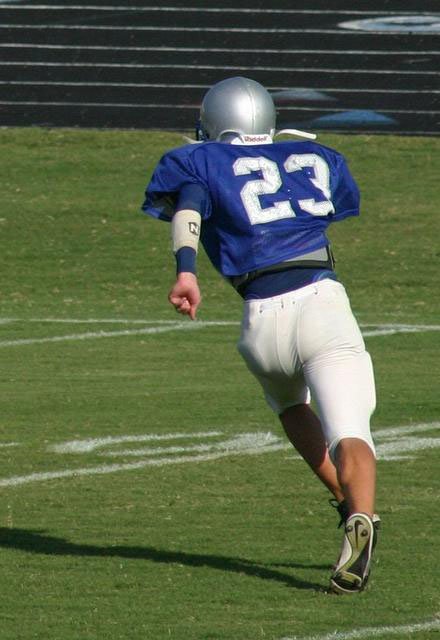
Players Should Be Careful Not To Compromise Acceleration And Speed With Extra Mass.
Receiver Terrell Owens (formerly)of the Dallas Cowboys is the perfect example of the successful merging of additional mass with speed and agility for exceptional performance. Strong safeties, whose responsibilities include a great deal of run support as well as covering tight ends and fullbacks coming out of the backfield could also benefit from additional mass.
Running Backs And Linebackers
Running backs and linebackers engage in heavy contact on most plays. They also perform near maximal sprinting and movements requiring rapid change of direction and acceleration. Because of the physical contact and ballistic nature of their position, the following are an absolute necessity:
- Body mass, strength, and power
- Back, neck, and abdominal strength for the stability and control of the spine during contact
- Mass development to help create and absorb the forces of physical contact
- General flexibility to enhance speed and performance as well as to decrease the incidence of injury
Running backs and linebackers tend to be heavier than receivers and defensive backs, but are smaller than linemen. Meanwhile, most linebackers tend to be a little heavier than running backs. Here again, the relationship between body mass and composition and physical performance is important and players should experiment during the off-season with the assistance of team strength and conditioning coaches.
Enhanced physical size and weight would offer an advantage during moments of impact and surges to gain a first-down. However, the extra mass should not compromise quickness, speed or game endurance.
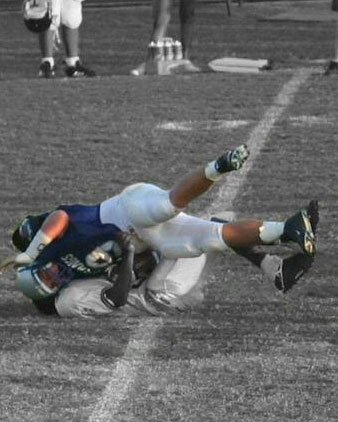
Enhanced Physical Size And Weight Offer An Advantage During Moments Of Impact.
Fullbacks tend to be heavier than and not as lean as a halfback. Their body type is ideal for running the ball "up the middle" and blocking. The halfback is the "feature back" on all teams and tends to be geared more toward off tackle and around-the-end quickness and speed.
The body fat level of halfbacks can be similar to that of receivers and defensive backs. The body fat level of fullbacks is usually closer to that of linebackers, which seems to average 14%.6
Most of the qualities that are advantageous for running backs also work well for linebackers, however, linebackers tend to be heavier (especially middle linebackers) than running backs. Outside linebackers are usually a little lighter and leaner than middle linebackers because they are more involved in pass coverage, blitzing, and tracking down ball carriers on end runs.
Offensive And Defensive Lineman
Linemen are generally the largest and strongest players on the field. Offensive and defensive linemen engage in physical contact on every play in an attempt to control the line of scrimmage. Players line up 2 to 3 yards from one another so there is little time or space to accelerate. For offensive and defensive linemen:
- Large mass is needed to produce force
- Power is crucial to control their area of the line of scrimmage
- Quickness is important, but it should not be at the expense of losing significant amounts of size and strength
Recommendations for optimal body compositions for linemen have not been proposed. However, most linemen will be able to determine the body weight and composition at which they are "at their best."
As mentioned, heavier linemen with a higher percentage of body fat can compromise quickness and agility and may not be able to endure four quarters of high-intensity play.7 Examples of this are apparent in the professional ranks when a 300+-lb defensive tackle with a higher amount of body fat becomes slower and less effective in the fourth quarter, or during long drives by the other team.
In addition, there is evidence to suggest that body fat levels may be related to the incidence of injury in linemen.8,9 For instance, high school football players with higher body fat levels have been assessed as having up to a 2 1/2 times greater risk of injury than leaner players.9
Physical Training For Football:
Physical training for football is based on the specific position played and its associated trait requirements (e.g. acceleration, speed, strength and power). Increases in body mass may be helpful for some players but are detrimental for others based on changes in speed and agility. These are discussed below as they relate to certain positions.
In addition, scouting combines often measure performance in the following activities:
- 40-yard dash
- Vertical jump
- Pro-agility shuttle, 3-cone drill
- Bench press performance (e.g. 225 lb rep count)
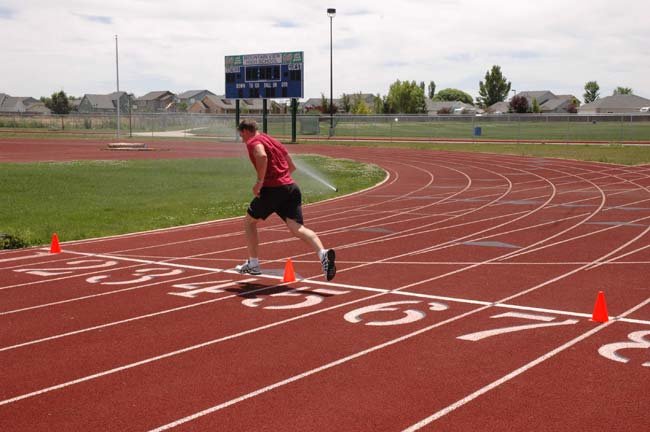
Pro-Agility Shuttle, 3-Cone Drill.
Certified strength and conditioning specialists will be able to utilize the significant findings to help better prepare athletes as they ready themselves for the Combines.
Receivers And Defensive Backs
The dynamics of this sport (strength, speed, power) suggest that a periodized program would be the most beneficial. Addressing the specific components within the preseason should maximize the training benefits at the opening of summer camp, but excessive muscular hypertrophy for these players (receivers and defensive backs) may not be beneficial as the increased mass could compromise speed and agility.
- Strength Training - Use multi-joint and Olympic movements to mimic athletic movements and to train the entire body simultaneously. These exercises improve coordination, stabilization, strength, and power. Several exercises focusing on flexibility, strengthening and stabilizing the hamstrings and lower back should also be included.
- Plyometric Training - Plyometric exercises assists in the development of speed and quickness.
- Conditioning Drills - These drills (e.g. cone drills) should emphasize footwork and maximize speed. Maximal and high-intensity endurance exercises should make up a majority of the conditioning. For improvement of speed, adequate amounts of rest (about 2 minutes) must be allowed between maximal effort exercises.
Running Backs And Linebackers
Running backs and linebackers need to consider muscle hypertrophy along with strength and power. A specific focus on each of these components suggests the use of a periodized program.
- Strength Training - Use of multi-joint and Olympic movements for strength training mimics athletic movements and trains the entire body simultaneously. These exercises improve coordination, stabilization, strength and power. Isolation exercises may assist in mass development.
- Plyometric Training - Use of plyometric exercises assists in the development of speed and quickness.
- Conditioning Drills - Conditioning drills should emphasize footwork including: change of direction and maximizing quickness. Most drills and conditioning should include 5 to 20 seconds of near maximal efforts with 20 to 30 seconds of rest between.
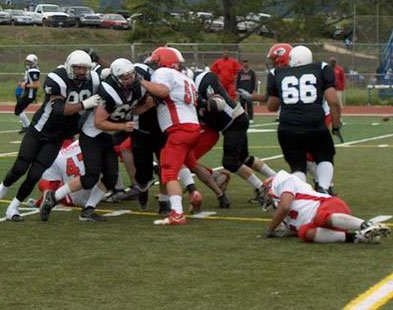
These Exercises Improve Coordination, Stabilization, Strength, and Power.
Offensive And Defensive Lineman
Because of the dual need for size and strength, a periodized program addressing both of these components is likely to produce the best results. Because of their large size, linemen often have poor flexibility and agility. Training should include exercises/actions that improve these areas.
- Strength and Power Training - Olympic movements in strength training can assist in developing total body coordination and maintain or improve flexibility. Utilizing the power lifts (squat, deadlift, bench press), one can develop large amounts of both mass and strength, so these should constitute a large portion of the training volume.
- Conditioning Drills - Conditioning drills for linemen should emphasize footwork and quickness. These drills should be performed in 10 to 20 seconds while covering short distances and with 20 to 30 seconds of rest between repetitions.
Nutrition For Football:
Nutritional concerns and requirements of football players must be taken into consideration with the unique physical attributes and performance requirements of the different position groups.
In addition, if changes in body weight and composition are desired to maximize performance, the player's diet will absolutely be affected. For instance, if a lineman wishes to add weight, consisting primarily of muscle mass, during the off-season he will need to ingest a calorie intake greater than his energy requirement.
Receivers and defensive backs may be more inclined to restrict their energy intake during the off-season to promote weight/fat loss.
Energy Intakes And Requirements:
As mentioned prior, there is a definite trend over the past decades for football players to become bigger, particularly in the case of linemen.1 In relation, energy intakes can be staggering with caloric levels increasing in proportion to position size. For instance, energy consumption of college linemen can be approximately 5000 to 6000 kcal daily and linemen might consume an additional 1500 kcal more daily than defensive backs.10

There Is A Definite Trend For Football Players To Become Bigger.
Carbohydrate
Maximal effort sprints separated by limited periods of rest dictate a strong reliance on muscle glycogen. Training drills allow for adaptations that increase carbohydrate storage capacity in muscle.
A diet providing at least 55-60% of its energy as carbohydrates or 7 to 10 g/kg body weight is ideal and will support recovery of glycogen stores after practices and games.
Good sources of carbohydrate include breads, pastas, fruits, dairy and some nutrition supplements. Game times are usually around the noon hour, late afternoon or early evening and players need to be conscious of their carbohydrate consumption earlier in the day.
Recently, the use of larger carbohydrate sources that rapidly move through the stomach for faster digestion and absorption has become popular with football players.
One such product does just that - Vitargo S2 is a unique high molecular weight starch carbohydrate proven in university studies to empty from the stomach over twice as fast as sugars and maltodextrin, providing fast fuel.11 This means far less discomforting content in the stomach during training, practice or games. It also means that a player can consume more fuel via [this product] without the typical bloating concerns.
Sport drinks containing 4 to 8% carbohydrate should be consumed during games and practices in amounts appropriate for maintenance of optimal hydration. For instance, if a running back were to drink 4 cups ([approximately] 1000 ml) of a 6% carbohydrate beverage during a game, he would have consumed approximately 55 g of carbohydrate in addition to the fluid.
As an alternative for players whose stomach is more sensitive to lower molecular weight carbohydrate (e.g. sugars and maltodextrin) beverages can use [this great product] immediately before practice and games and on the sidelines and during halftime.
Strategic carbohydrates are especially important during 2-a-day practice schedules where there is minimal time to recover spent glycogen stores in between training.
For instance, because [this product] is a rapidly digested and absorbed carbohydrate it has been proven in research to accelerate glycogen recovery (based on biopsies of the quadriceps muscle) after exhaustive exercise leading to a faster return to higher performance compared to simpler sugars and maltodextrins.12,13
Protein
Although protein needs have not been specifically determined for football players, their requirements are higher than those of the general population because of their greater muscularity and training, as well as injury recovery.
A diet providing 15--20% of its energy from protein should provide enough protein to achieve nitrogen balance and desirable gains in LBM provided the calorie level meets daily needs. Expressed another way, protein intake of 1.2 to 1.7 g/kg of body weight should be adequate and allows for differences in training and conditioning practices among players.
Here is how these levels might translate to football players:
- For a 195-lb athlete ([approximately] 88 1/2-kg) safety eating 4000 kcal daily with 15% attributable to protein, this equates to 150 grams of protein or roughly 1.7 g/kg of body weight. (College defensive backs have been noted to consume roughly 16% of their energy as protein.16)
- An offensive lineman weighing 275 lb (125 kg) and consuming 5000 kcal with 17% derived from protein would receive 212 g of protein, which would equate to 1.7 g/kg of body weight.
Protein from animals is rich in essential amino acids and in particular branched chained amino acids (BCAA). This includes red meat, poultry (meat and eggs), fish and milk (dairy).
Soy is also a good source of essential amino acids, but its leucine (a branch chain amino acid) content isn't quite as high as whey protein. However most combinations of protein sources consumed before or after a workout will support muscle development especially if the level of intake is significant.
Supplement manufacturers target single protein ingredients such as whey protein isolate (WPI) or a blend of protein ingredients to create a more strategic muscle development food. Protein fractions from milk namely, WPI, whey protein concentrate (WPC) and casein can be used strategically as whey is more rapidly digested and absorbed than casein. This has led to the idea of "fast" and "slow" protein which is equivalent to a time-release system.
Protein timing, or the importance of protein either before or immediately after a workout to maximize gains in muscle development and performance, is important to football players. Resistance training sessions results in a simultaneous increase in protein synthesis and breakdown.
Several studies clearly indicate that protein, and more importantly essential amino acids, are critical to maximize gains.14,15 Some studies suggest that milk based proteins may offer an advantage over soy protein at least at the levels studied.16 In addition, consuming faster-acting carbohydrate to rapidly raise insulin (e.g. Vitargo S2) after training will support optimal results.
A recent university study showed that a 100-gram dose of [this faster-acting carbohydrate] raised insulin levels [a lot] higher than an equal amount of carbohydrate from maltodextrin and sugars within as little as 10 minutes after consumption.12 Insulin is the most potent natural way to stop muscle protein breakdown after training and is involved in the transport of amino acids and other vital nutrients into muscle during recovery.
Fluids And Hydration
Hydration status is a primary nutritional consideration for football players. Warmer climates, padding and uniforms can increase sweat losses.
Copious water consumption is necessary, especially during preseason camps in the summer months. Also, during high school, college and professional summer football camps it is common for teams to practice twice a day. Football players must strive to recover water losses between those practices.
Mesh jerseys may be worn during practices and games with the arms and lower legs often being exposed. This allows for greater heat loss via convection. Plastic and foam protective gear such as helmets, shoulder pads, hip girdles and arm pads decrease the potential for heat loss via convection.
Often, quarterbacks wear a protective "flak jacket" under their jersey. This apparatus greatly decreases heat loss from the torso via convection.
Efficient heat removal is imperative for these large athletes, and a few recent deaths of linemen have been attributed to heat intolerance during summer practice. Fans, mist-machines and other sideline devices can help cool these athletes and decrease sweating reliance.
Linemen tend to sweat more than other positions based on their total size. For instance, NFL linemen had a sweat rate averaging 2.4 liters/hour vs. 1.4 liters/hour for running backs practicing on a warm, sunny day.17
Without question, consuming either water (pure) or sport drinks would benefit a football player's hydration status. These athletes should drink fluids before, during, and after games and practices, especially in between two-a-day practices which can lead to significant daily fluid losses.18 A sport drink should be beneficial; however, the carbohydrate should not exceed 8% to allow for rapid emptying from the stomach.
Estimating Fluid Needs During Training, Practice And Games:
Players can estimate their fluid needs during practice or a game by:
- Weighing themselves prior to and after a practice
- Factor in how much fluid they drank during practice or a game
Assume: One pound of body weight approximates 1/2 liter or 16 oz (2 cups) of fluid.
Vitamins And Minerals
Football players tend to consume at least the generally recommended amounts of vitamins and minerals because of the higher volume of food they eat.
However, an exhaustive study of vitamin and mineral metabolism and relative needs to football players remains to be performed. For instance, some researchers and nutritionists feel that the required level of intake of several B-vitamins should be higher for athletes based on energy expenditure.19 Also, requirements for vitamin B6 are based on protein/amino acid consumption which would lead to greater needs for many football players.
Perhaps the greatest immediate concern is related to mineral losses experienced during sweating. Sport drinks providing sodium at approximately 110--165 mg/8 oz and potassium at 19--46 mg/8 oz should provide ample electrolytes to recover losses when fluid consumption covers sweat loss.
Based on incomplete knowledge and common dietary habits of high school and college athletes, it is generally recommended that football players bolster their nutritional intake with a multivitamin and mineral supplement.
Recommendations For Pre/During/Post Training/Practice Or Game
Some general recommendations for nutrition consumption before, during and after training, practice, and games are listed below. Football players should experiment with all aspects to determine what works best for them during training and practices to optimize game performance.

Players Should Experiment To Determine What Works Best For Them To Optimize Performance.
Recommendations are provided in ranges and smaller players (receivers and defensive backs) can strive for the lower end of the range while bigger linemen should aim towards the higher end of the range.
Workout/Practice/Game Preparation (3 to 4 Hours Before) - This meal will help prepare energy stores for strenuous training or scrimmage as well as contribute to daily needs.
- 100-200 gram of carbohydrate
- 25 to 50 grams of protein
- 1/2 to 1 liter (16-32 oz) of fluid (Continue to sip on fluids up until practice/ game in heat)
Pre-Workout/Practice/Game/Training ([approximately] 30 minutes Before)
- 10 to 30 grams of rapidly digested and absorbed carbohydrate
- Drink 400 to 600 ml of fluid 2 to 3 hours prior to a game/practice to maximize hydration status at the start
During Practice/Game/Training
- Drink at least 250--300 ml of fluid every 15--20 minutes of play (more (300--500 ml) if sweating is heavy)
- Sideline and halftime allows for a great opportunity to stay hydrated
Post-Workout/Practice/Game (Immediately/ASAP)
- > 35 to 50 grams of carbohydrate
- ≥ 1/4 to 1/2 gram of protein per kg body weight (about 1/8 to 1/4 grams per lb)
- Continue to drink fluids over the next hour or two until you have recovered the weight you lost during practice or game
Nutrition Supplementation By Football Players:
Football players tend to be regular users of nutrition supplements. In developing a supplement strategy, football players should assess their needs relative to position and goals. Below are the keys reasons why football players use certain nutrition supplements as well as brief reviews of creatine and beta-alanine.
Principal Reasons For Supplementation By Football Players
- Energy/Focus
- Fueling/Refueling
- Mass/Strength Development
- Recovery (Post Training)
- Hydration/Rehydration
- Fatigue Resistance
Key Supplements For Mass, Strength And Power
Creatine - Creatine is one of the more recognizable supplements used to enhance strength and power and LBM. A body of evidence supports the notion that creatine can promote weight gains, primarily in LBM, which coincides with potential gains in strength.
While many forms of creatine exist on the market, creatine monohydrate is by far the most studied and proven effective.1 Football players can derive benefit from 3 to 5 grams of creatine daily.
Some research studies have used higher levels as well. For instance, 15.75 g of creatine monohydrate, as part of a glucose/taurine/electrolyte supplement, promoted greater gains in fat- and bone-free mass, isotonic lifting volume and sprint performance during intense resistance/agility training in college football players.20
Beta-Alanine - Beta-alanine is naturally found in meats and is structurally different from alanine and the other amino acids that can be used to make proteins. However, β-alanine can be combined with histidine to make L-carnosine. Carnosine is an important acid buffer in muscle cells especially Type II muscle fiber cells. However, ingested carnosine is extensively broken down in the blood and thus supplementation of carnosine does not efficiently and cost-effectively increase muscle carnosine levels. Meanwhile β-alanine can enter muscle cells and be used to make carnosine.
Researchers are finding that supplemental β-alanine is indeed effective in raising muscle carnosine levels as well as improving the muscle acid buffering abilities during high intensity activities such as sprinting and weight training. This in turn is related to improvements in performance.21-23
Caffeine And Performance
Caffeinated beverages such as coffee, colas and energy drinks are popular and many players must be considered. Caffeine can be added to energy drinks and other products simply as itself or in herbs such as guarana and yerba mate.
Although some caffeine prior to a workout, practice or game may be beneficial for some football players, excessive consumption can hinder performance as well. Some football athletes may feel lethargic from heavy caffeine consumption a few hours prior to practice or a game. Also, caffeine is listed on the banned substance list for the NCAA at urine levels that would exceed 15 mcg/ml.
Taking It To The Field:
Game competition is fierce as adversaries on the other side of the line of scrimmage have the same goal as you - to dominate their position and be victorious in their efforts. Moreover, competition can be brutal among teammates as you fight for a starting position.
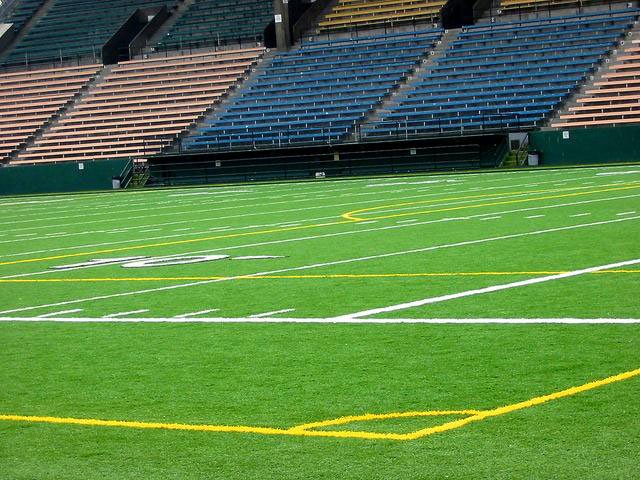
Use The Tools You Need To Optimize Your Performance On The Field.
Strategic training and effective skill development combined by proper nutrition are the tools you need to optimize your performance on the field. Take advantage and control but take no prisoners. It's up to you and no one else! Leave it all on the field and strive for nothing short of victory.
References
- Williford HN, Kirkpatrick J, Scharff-Olson M, Blessing DL, Wang NZ. Physical and performance characteristics of successful high school football players. American Journal of Sports Medicine 22(6):859--862, 1994.
- Parks PS, Read MH. Adolescent male athletes: body image, diet, and exercise. Adolescence 32(127):593--602, 1997.
- Kraemer WJ, Torine JC, Silvestre R, French DN, Ratamess NA, Spiering BA, Hatfield DL, Vingren JL, Volek JS .Body size and composition of National Football League players. J Strength Cond Res. 2005 Aug;19(3):485-9.
- Noel MB, VanHeest JL, Zaneteas P, Rodgers CD. Body composition in Division I football players. J Strength Cond Res. 2003 May;17(2):228-37.
- Sierer SP, Battaglini CL, Mihalik JP, Shields EW, Tomasini NT. The National Football League Combine: performance differences between drafted and nondrafted players entering the 2004 and 2005 drafts. J Strength Cond Res. 2008 Jan;22(1):6-12.
- Wilmore JH. Body composition in sport and exercise: directions for future research. Medicine and Science in Sports and Exercise 15(1):21--31, 1983.
- Miller TA, White ED, Kinley KA, Congleton JJ, Clark MJ. The effects of training history, player position, and body composition on exercise performance in collegiate football players. Journal of Strength Conditioning Research 16(1):44--49, 2002.
- Gomez JE, Ross SK, Calmbach WL, Kimmel Schmidt DR, Dhanda R. Body fatness and increased injury rates in high school football linemen. Clinical Journal of Sports Medicine 8(2):115--120, 1998.
- Kaplan TA, Digel SL, Scavo VA, Arellana SB. Effect of obesity on injury risk in high school football players. Clinical Journal of Sports Medicine 5(1):43--47, 1995.
- Short S, Short WR. Four-year study of university athletes' dietary intake. Journal of the American Dietetics Association 82:632--642, 1983.
- Leiper JB, Aulin KP, S?derlund K. Improved gastric emptying rate in humans of a unique glucose polymer with gel forming properties. Scandinavian Journal of Gastroenterology 2000 ;35:1143-1149.
- Stephens FB, Roig M, Armstrong G, Greenhaff PL. Post-exercise ingestion of a unique, high molecular weight glucose polymer solution improves performance during a subsequent bout of cycling exercise. Journal of Sports Sciences, 2008; 26(2): 149-154.
- Aulin KP, S?derlund K, Hultman E. Muscle glycogen resynthesis rate in humans after supplementation of drinks containing carbohydrates with low and high molecular masses' European Journal of Applied Physiology, 2001; 81: 346-351.
- Tipton KD, Elliott TA, Cree MG, Aarsland AA, Sanford AP, Wolfe RR Stimulation of net muscle protein synthesis by whey protein ingestion before and after exercise. Am J Physiol Endocrinol Metab. 2007 Jan;292(1):E71-6.
- Tipton KD. Ferrando AA. Improving muscle mass: response of muscle metabolism to exercise, nutrition and anabolic agents. Essays Biochem. 2008;44:85-98.
- Phillips SM. Hartman JW, Wilkinson SB Dietary protein to support anabolism with resistance exercise in young men. J Am Coll Nutr. 2005 Apr;24(2):134S-139S.
- Godek SF, Bartolozzi AR, Burkholder R, Sugarman E, Peduzzi C. Sweat rates and fluid turnover in professional football players: a comparison of National Football League linemen and backs. J Athl Train. 2008 Apr-Jun; 43(2):184-9.
- Godek SF, Godek JJ, Bartolozzi AR. Hydration status in college football players during consecutive days of twice-a-day preseason practices. Am J Sports Med. 2005 Jun;33(6):843-51.
- Wildman REC, Miller BS. Vitamins and Exercise, In: Sport and Fitness Nutrition. Thomson/Wadsworth Publishing 2004.
- Kreider RB, Ferreira M, Wilson M, Grindstaff P, Plisk S, Reinardy J, Cantler E, Almada AL. Effects of creatine supplementation on body composition, strength, and sprint performance. Medicine and Science in Sports and Exercise 30(1): 73-82, 1998.
- Derave W, Ozdemir MS, Harris RC, Pottier A, Reyngoudt H, Koppo K, Wise JA, Achten E. beta-Alanine supplementation augments muscle carnosine content and attenuates fatigue during repeated isokinetic contraction bouts in trained sprinters. J Appl Physiol. 2007 Nov;103(5):1736-43.
- Stout JR, Cramer JT, Mielke M, O'Kroy J, Torok DJ, Zoeller RF. Effects of twenty-eight days of beta-alanine and creatine monohydrate supplementation on the physical working capacity at neuromuscular fatigue threshold. J Strength Cond Res. 2006 Nov;20(4):928-31.
- Hoffman J, Ratamess N, Kang J, Mangine G, Faigenbaum A, Stout J. Effect of creatine and beta-alanine supplementation on performance and endocrine responses in strength/power athletes. Int J Sport Nutr Exerc Metab. 2006 Aug;16(4):430-46.


